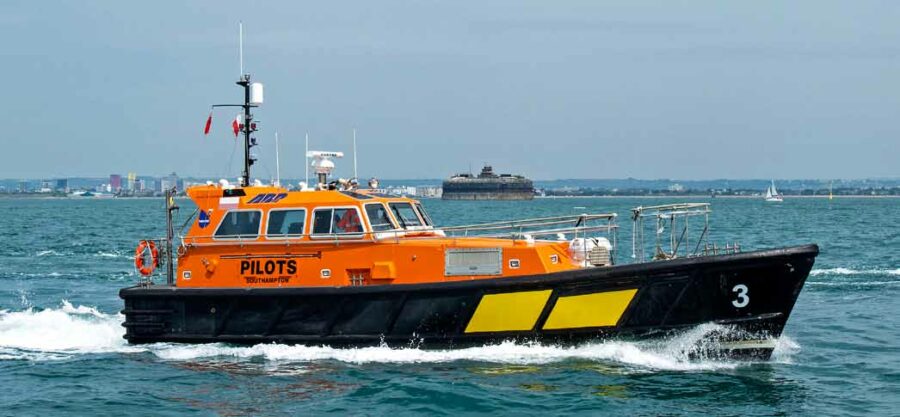Inshore fishing activities in the UK are frequently conducted in close proximity to extremely busy pilot stations, and to restricted navigation channels used by some of the biggest commercial ships in the world. Fishing News was recently invited to share this experience by pilots and cutter crews in the Solent. John Periam reports (Photos: Geoffrey Lee)
Main image: ABP coxswain marine officer Paul Tomlinson at the helm of Hampstead, leaving its Gosport home base, with Portsmouth’s Emirates Spinnaker Tower in the background.
Some 3,000 vessel movements can be recorded in the Solent on a busy day, however, the minor incident rate is well below 1%. The fact that cruise, tanker and container ships are continually getting bigger puts added responsibility on the ships’ pilots and their cutter crews. The same is happening around the UK’s other major shipping ports, some of which are also experiencing a significant increase in the number of fastmoving vessels associated with renewable energy.
Ryan Hall is Southampton Port’s pilotage services manager, and he kindly extended an invitation to Fishing News last month to see how the pilots of Associated British Ports (ABP) operate in the Solent, while supporting the region’s fishermen.
“We like to work closely with the U10 fishermen who make a living from fishing in the Solent. They are reliable, trustworthy, and make a concerted effort to understand how we operate,” said Ryan. “Our concerns are more with the pleasure craft and angling boats that may not be aware of the speed and size of some of these larger vessels. “At times, some of these ships can be moving at a speed of 20 knots. It might look small in the distance, but things happen quickly. For example, later today, we have CMA CGM Antoine de Saint Exupery entering the port. It is one of the world’s largest container ships, with 2,100 containers on board, reaching a height of 60m on deck. It is 400m long, with a draft of 15m+, and weighs in excess of 200,000t. To get to the bridge, there is a lift going up nine floors, followed by two more sets of stairs.
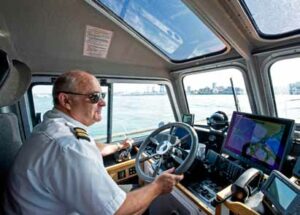
Coxswain marine officer Paul Tomlinson at the helm of Hampstead, a Halmatic Nelson 48/50 boat, watching the radar screens displaying the busy shipping traffic in the Solent.
“The number-one rule for the pilots operating on the bridge is ‘if you can’t see us on the bridge, we can’t see you’. As a result, it is important that you let us know of your intentions early – rather than not at all. A ship travelling at 10 knots is doing a mile every six minutes.”
Chris Hoyle is an Unrestricted First Class pilot specialising in bulk container shipping. “For fishermen around all UK waters, the following guidance may help with the larger and faster vessels now being built, when it comes to working near a large port or a pilots’ boarding station, which can be as far as 10 miles out to sea. It is wise to maintain a good lookout, even if fishing single- handed, using both sight and hearing. Monitor radio channels 12 and 16, and be aware of the speed of vessels.
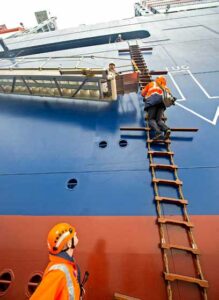
ABP pilot Chris Hoyle climbing one of the 19 steps to board CMA CGM Antoine de Saint Exupery, while second coxswain Matt Stubbs keeps a watchful eye.
“There are marked pilots’ boarding areas on charts, so please try not to fish in those areas, however tempting it may be. If you do, check on all shipping movements (port websites show all departures and arrivals). Due to their size, they have to remain in designated waters, and cannot move out of the way like fishing boats can.
“I am not trying to teach fishermen their job, but would like to help them to remember some key facts. If you are fishing single-handed then there is no one to report to, so think of yourself and be very much aware of what is happening. Time passes very fast when hauling pots, and a ship 10 miles away can be on top of you in less than half an hour. Allow extra time for poor visibility.
“Water space is shared, and commercial traffic – which includes fishing boats – is more predictable, as it keeps in regular contact with other agencies involved in working with the region’s fishermen. Vessels with pilots on board are limited as to where they can go, but others are not, and these is what those in the Southampton Vessel Traffic Services (VTS) operations room have to be aware of. “Safety is of vital importance, and all major ports work closely with the Maritime and Coastguard Agency (MCA) and the Royal National Lifeboat Institution (RNLI). The National Maritime Operations Centre (NMOC), based at Fareham, also monitors all shipping.
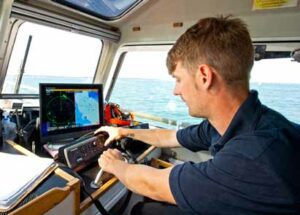
Second coxswain Max Dillingham checking the positions of shipping on the split-screen radar and plotting displays en route to a call-out.
The use of mobile phones is a major concern when at sea. Avoid them, and get a proper VHF radio – that can save lives, as well as a lot of time when it comes to inter-ship communications.”
Ryan Hall could not emphasise enough the respect he has for the UK fishing fleets. Technology has changed, but there are still limitations, and that is when it comes down to the experience of the skipper of a fishing boat, however large or small it is.
This was endorsed by Steve Hornbuckle, watch manager for Southampton VTS. “I have seen the working relationship between us and the professional fishermen over many years. I respect
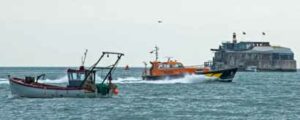
A local fishing boat returning to port, with ABP Hampstead passing close by to transfer a pilot to a tanker, with Spitbank Fort in the background.
their judgement and experience. Times are not easy for them at the moment, and that is when, through no fault of their own, risks may be taken to get a specific catch. We proactively manage traffic movements in accordance with relevant byelaws, and are first responders for any incident, including the MCA, which is our first external communication in any emergency. This is an added bonus for the region’s fishermen.”
“Our ships’ pilots are career professionals with Master Mariner’s tickets, and know their specific operational waters well”
Ryan Hall said: “Our pilots are career professionals with Master Mariner’s tickets, and know their specific operational waters well, as do all pilots around the UK.” So how does one become a ships’ pilot? “A good background is in ship handling, which is doing the actual hard work of bringing a ship alongside or taking her off a berth. If you can imagine, each pilot does about 230 vessel movements a year. There is a 13-week express training period, in which they go in and out of their relevant port every single day, visiting all types of shipping. They are examined and become a Class 2 pilot, working on ships up to 110m, such as small tankers. They do this progressively for five and a half years, until they become a Class One Unrestricted pilot. They would not be doing this if they did not enjoy piloting ships – it is a chosen vacation,” Ryan Hall stressed.
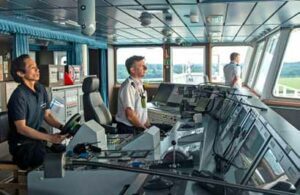
ABP pilots Chris Hoyle and Neil Dunn focus on navigating CMA CGM Antoine de Saint Exupery and passing instructions to the ship’s helmsman.
“At Southampton we have 47 ships’ pilots and 20 pilot cutter crews, who operate the four Halmatic Nelson 48/50 pilot cutters, which are equipped with two D13 Volvo engines and operate on a 24-hour watch system. These are supported by the harbour master’s patrol launch, which escorts any large vessel into port. This is there to help move any small vessel that may be in one of the designated shipping lanes, which cannot be seen from the ship’s bridge.” Chic Stewart is the pilot desk operator for Southampton, and his job is to look after all 47 pilots who are rostered, on average, nine a day. “They work a 24- hour shift from 8.30am. I will contact them giving them their job, depending on the size of the vessel. We ask pilots to call in the night before their duty to get an idea of what is involved, eg, ingoing or outgoing ship. With cruise ships they often board well in advance, and are ready and waiting, as most cruise ships berth in the early morning and you can have several waiting at one time.
“For fishermen, this is a time to be aware of such movements, as they are often close to their fishing grounds, and it is a time when fishermen are often positioning themselves, especially when it comes to potting.
“I do make a point of updating the pilots during the day, depending on how busy the Solent is. Sometimes it can result in three boardings a day, in all weather conditions. Even for the experienced, it can at times be very daunting to be alongside one of the larger vessels, travelling at between eight and 12 knots, having to prepare to board one of the long ladders (still the most proven route). All pilots wear SeaSafe integrated lifejackets and protective clothing.”
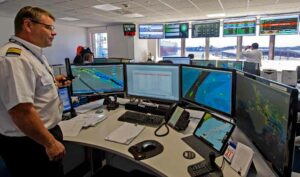
Watch manager Martin Thomas in the Vessel Traffic Services operations room, leading his team of Matthew Dann (left) and Raymund Abosejo, watching movements through the binoculars.
Southampton is the secondlargest commercial port in the UK, and like all others it is expanding and having to take on larger vessels. Cruising is on the increase, and vessels require a quick turnaround. The workload is getting bigger, and it’s important that the increase in shipping movements is monitored on a regular basis, making life for our fishermen that much safer.
All shipping in the Solent is controlled by Southampton Vessel Traffic Services, which manages about 130,000 movements a year from the operations control room at the port office.
“In layman’s terms, it is the air traffic control of the Solent, tracking the movements of all ships, including fishing boats and pleasure craft. Fishermen want to know that, when they fish around major ports, they are being looked after. Rest assured, we make a concerted effort to do just that,” said control manager Mike Toogood.

